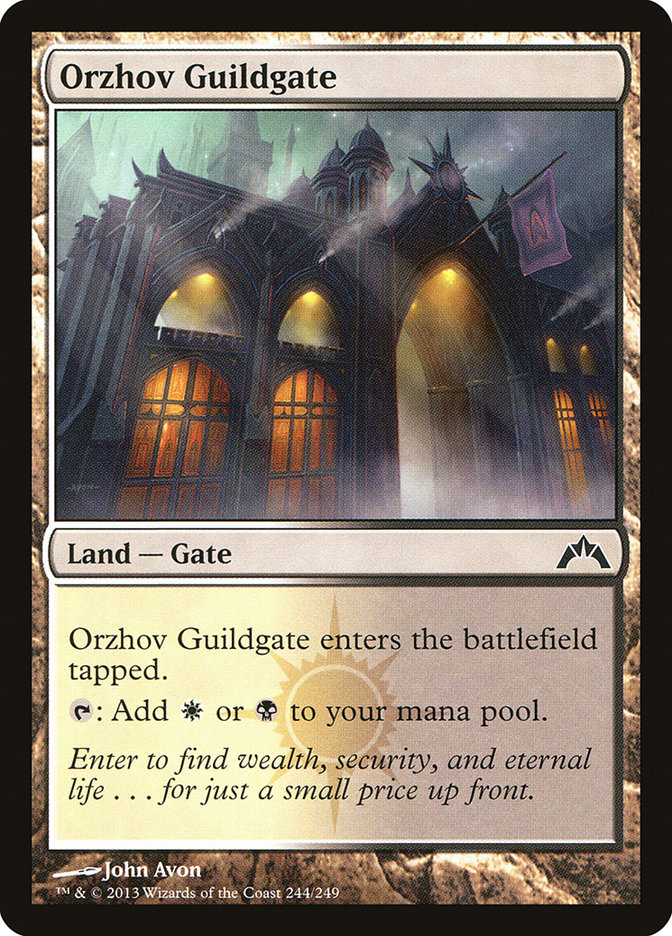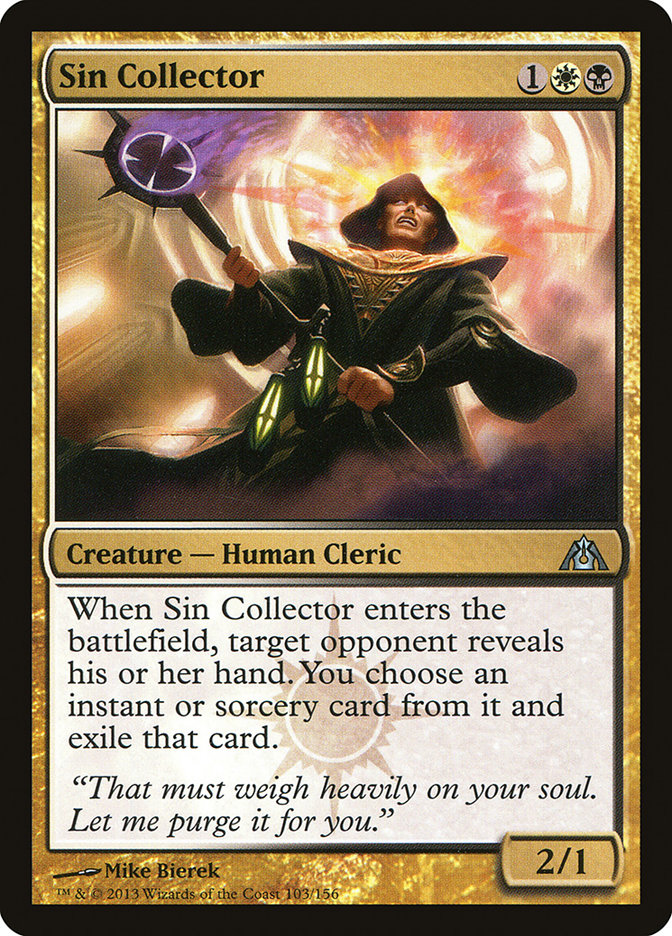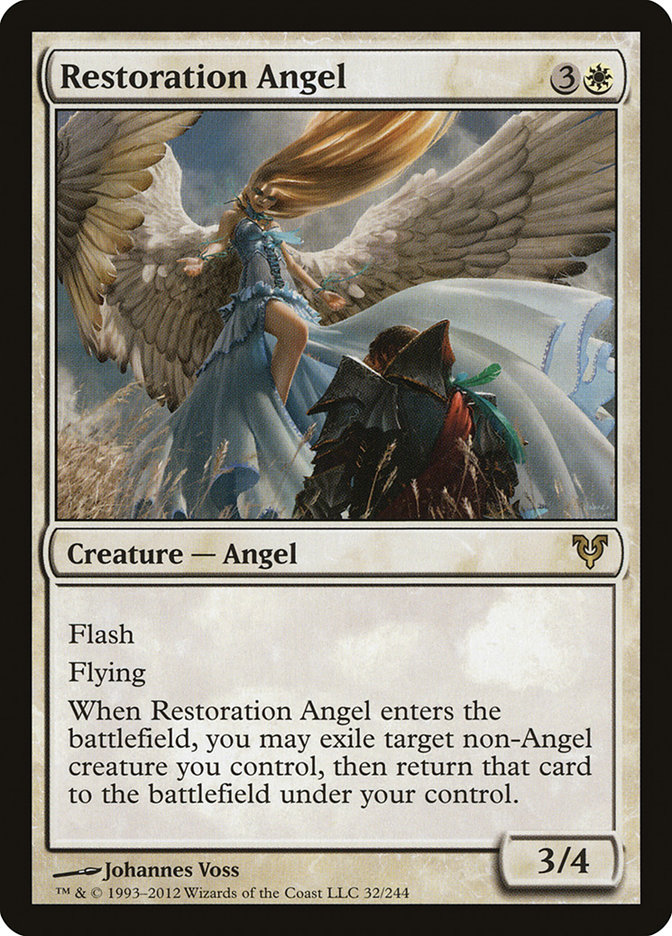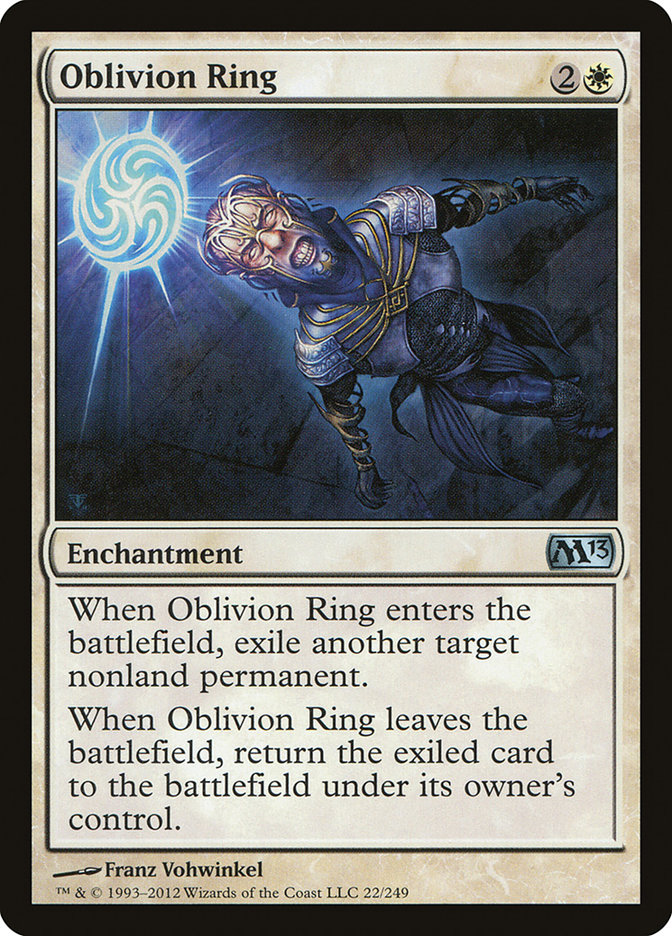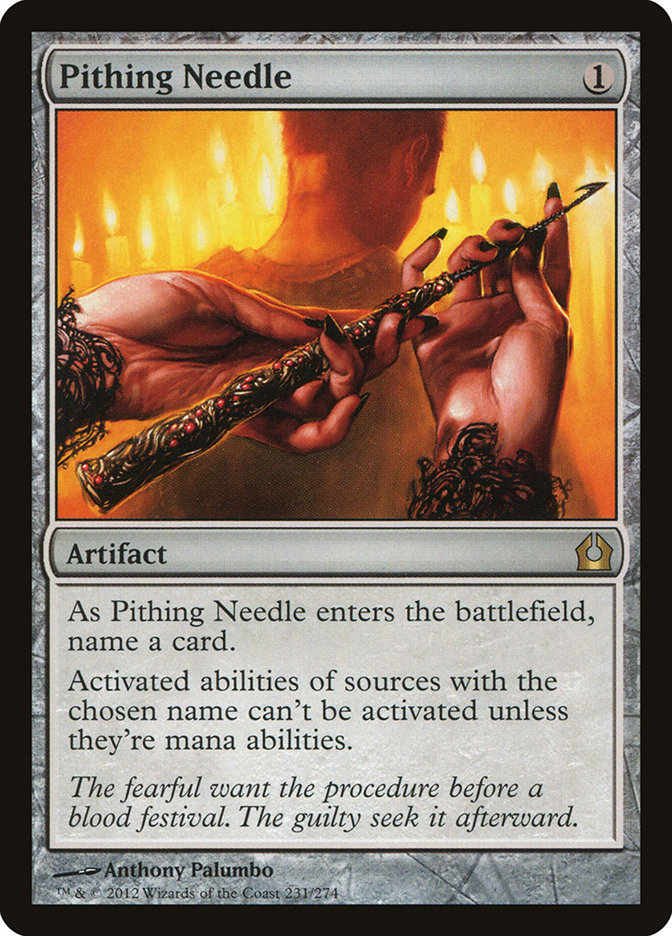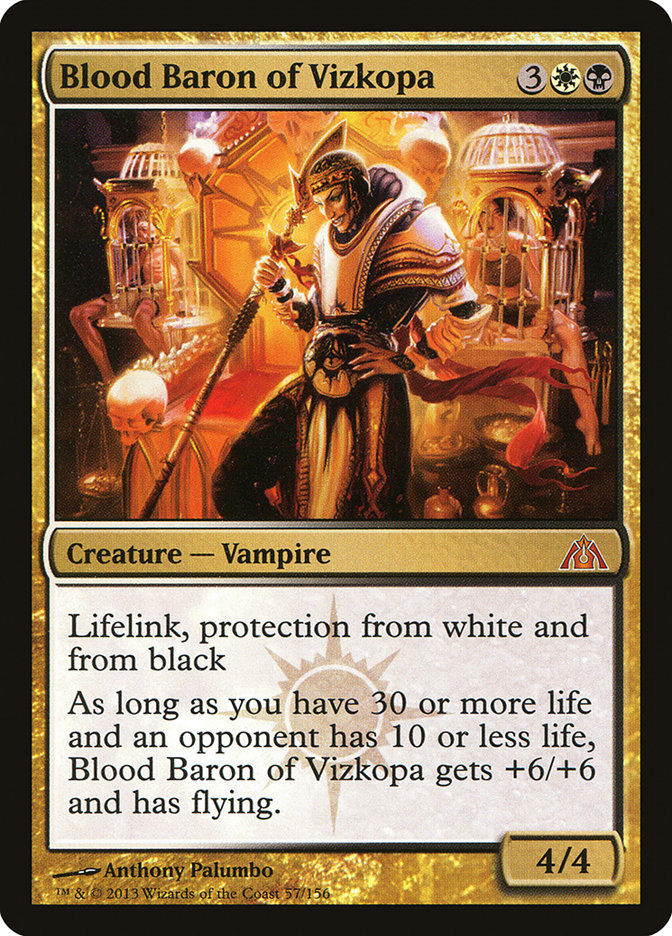A few months ago, I wrote an article about how a lucky Orzhov Guildgate that I rescued from abandonment stuck with me all the way through to winning a PTQ (and was then later abandoned again). A lot of hard work and perseverance also applied, but let’s be real—it was all the Guildgate. With Theros rapidly approaching, I find myself falling into a rut again in Standard. While my trusty fallback, Junk Reanimator, is always there and still very valid, I simply want to experiment with new things. I don’t want to be known as just a one-trick pony.
Let’s be clear. Being a two-trick pony would be perfectly acceptable, but just one-trick? Give me a break. You’re selling me short. One trick short to be precise. Gotta respect that second trick.
As a result, I turned to the only place I knew I could to find inspiration
Only instead of carrying it around in my pocket as it turned into a gnarled mass, I decided to just go ahead and sleeve it up this time. This time it wasn’t just going to sit there and give me good luck. This time it was going to actually take an active role in my luck. This time it was always going to be there when I need it most: sitting on top of my deck when I desperately need to draw a land that comes into play untapped.
So what is this deck that features Orzhov Guildgate? It is actually just a variant on the B/G Midrange deck that has experienced a lot of success in the past few months. Instead of playing green for cards like Scavenging Ooze and Thragtusk, it instead dips into white for heavy hitters like Restoration Angel and Blood Baron of Vizkopa. White also provides access to cards like Oblivion Ring and powerful sideboard options like Obzedat, Ghost Council.
A few others have hinted at decks in the same vein in the past week, such as [author name="Brian Kibler"]Brian Kibler[/author] last Friday and [author name="Valeriy Shunkov"]Valeriy Shunkov[/author] earlier this week. In that time, I have been battling with my own versions of the list on Magic Online.
Without further ado, I present the deck I have begun to affectionately call "Orzhov Guildgate." That’s not to be confused with a very similar-looking list entitled "I can’t ****ing believe I drew another ****ing Guildgate when any untapped land would win me the game." That’s a different list altogether.
Creatures (18)
- 3 Geralf's Messenger
- 4 Restoration Angel
- 2 Disciple of Bolas
- 4 Desecration Demon
- 2 Blood Baron of Vizkopa
- 3 Lifebane Zombie
Planeswalkers (3)
Lands (25)
Spells (14)

Before I jump into some of the cards that are in this deck, I want to first touch on a card that is conspicuously absent. One of the main reasons to play B/W is the ability to get huge value from cards like Restoration Angel alongside Lifebane Zombie and Sin Collector.
Well, I’m not running any Sin Collectors. I started with three copies in my sideboard. As I progressed with the deck, I cut that number to two, then one, then eventually none. The issue with Sin Collector is that a lot of the scariest cards in the format for this deck to beat are planeswalkers and enchantments. I didn’t want to bring in Sin Collector against a deck like Jund because the body is irrelevant and it can’t even grab some of the more powerful cards they could have against me, like Garruk, Primal Hunter; Liliana of the Veil; or Underworld Connections.
Duress just seemed like a better choice. Duress can grab all those planeswalkers, but it can also just as easily snag a Sphinx’s Revelation or Rakdos’ Return, much like Sin Collector. While you can’t abuse Duress the same way you can abuse Sin Collector and Duress is much worse against a card like Snapcaster Mage, it still has simply performed much better for me.
One of the main differences between the list I’ve been working on and the lists that I’ve seen others post is that mine plays three copies of Geralf’s Messenger. I think it is a giant mistake to not play with it. Not only does it have great synergy with both Mutilate and Restoration Angel, but it’s also just a huge pain in the side for any of the midrange or control decks to deal with. Messenger represents a strong clock by itself and typically requires two removal spells, or it trades with a creature and then still requires another removal spell afterward. I also like that Geralf’s Messenger will trade with both halves of a Thragtusk and also negate the life gain. Messenger is perfectly capable of busting a capsule in Thragtusk’s hide, and I’m not unhappy about it.
Another difference is that I keep seeing lists playing two or three Sign in Bloods instead of the full four. If you’re not prepared to get a little bloody, then this deck isn’t for you. That’s not a change I can sign off on. Play the full set. This is a midrange deck with 25 lands, no acceleration, and a desire to cast a very large amount of cards that cost four or five mana. How do you intend on hitting the land drops to cast those cards without access to a card like Sign in Blood to smooth out your draws?
This 3/4 flash flier that we’ve come to know and love as simply "Resto" is by far the most compelling reason to play white in the deck over something like green. So what exactly does Restoration Angel offer?
Well, for one, you can’t target your Mutavault or your Blood Baron of Vizkopa with her ability. Still not convinced she’s the right fit? Well, I guess I have to elaborate further.
Restoration Angel plays a lot of the same kind of role in this deck that she plays in the Junk Reanimator deck. This deck has a number of creatures that are all weak or strong in different matchups. Restoration Angel lets you double up on the good ones in the matchups they are good against.
Playing against Jund? Let’s keep jamming our Geralf’s Messenger into their Thragtusks and then reset them with Restoration Angel. Playing against Elves or Junk Reanimator? Let’s keep blinking that Lifebane Zombie to strip them of relevant threats. Playing against G/B Midrange? Let’s have a second go at that Disciple of Bolas to draw a bunch of cards.
Not only is curving Geralf’s Messenger into Disciple of Bolas into Restoration Angel on the Disciple one of the dirtiest things you can do, but Restoration Angel also has some synergy you may not expect with an unlikely ally: Desecration Demon.
Not only do Restoration Angel and Desecration Demon sound like the names of the Hero and the Villain in a comic book world, but Restoration Angel on Desecration Demon also falls into a certain category of threats that I like to call "The Hot Rod Threat." There are a lot of different kinds of threats you can make to someone. You can threaten to hurt them, threaten to not call them again, threaten to take away their favorite stuffed animal, and many more. If you go far deeper, there is one more level of threat. The Hot Rod Threat. If you’re not familiar with the film, in the movie Hot Rod, the main character spends the entire movie trying to raise enough money to save his stepdad from dying—just so he can then later beat the crap out of him in a fight.
"I’m going to beat you within an inch of your life . . . then I’m going to spend the next two weeks carefully and lovingly nursing you back to full health . . . just so I can beat you within an inch of your life again." That’s an example of a perfectly executed Hot Rod Threat.
Restoration Angel and Desecration Demon is another perfectly executed Hot Rod Threat. You desecrate them, and then you bring about restoration, just so you can then desecrate them yet again.
One of the most unfair yet fun things you can do in this deck is have your opponent sacrifice a creature to your Desecration Demon in hopes of getting in with their creatures, only to have you then Restoration Angel the Desecration Demon and blow them out in combat by killing multiple attacking creatures. I usually have to take a shower after this happens because it’s just so dirty.
Desecration Demon’s trigger is an ability that happens only once per turn, so after they’ve decided to sacrifice to appease the Demon, the only sacrifice they’re going to be able to make the rest of the turn is sacrificing their entire board state when you "save" Double Deez with a Restoration Angel and declare what they would probably decide are "unfavorable blocks." It’s possible they may also sacrifice their will to continue the match, but that isn’t a given.
This deck has a lot of removal and a lot of buff creatures, like Desecration Demon and Restoration Angel, that can make combat difficult for your opponent. What it lacks, however, are ways to deal with some problematic noncreature permanents your opponent might play. A prime example of this is Domri Rade out of the Naya and G/R decks or Garruk, Primal Hunter out of Jund. Oblivion Ring has been an invaluable answer to those cards. I started with one copy and quickly upped to a second, and I wouldn’t necessarily be opposed to a third.
This has been the best performing card in the sideboard. Needle serves as a great answer to a wide swath of problem cards: planeswalkers, Underworld Connections, Mutavault, Aetherling, etc. It’s very rare that a matchup doesn’t have a card worth bringing in Needle to contain. Even if you advance to a board position where you no longer need Pithing Needle for the original threat you boarded it in for, it can still be useful.
For example, if you side in Pithing Needle against The Aristocrats to deal with Sorin, Lord of Innistrad, you can still cast it to turn off their Falkenrath Aristocrat or Cartel Aristocrat in a pinch. If you side in Pithing Needle against B/G Midrange to deal with their Underworld Connections and they don’t have one, you can still shut down Scavenging Ooze, Ratchet Bomb, Mutavault, Vraska the Unseen, or Liliana of the Veil if you need to. While those aren’t optimal uses, the versatility of Pithing Needle means that it’s rarely dead even when you draw it late.
It may seem counterintuitive to bring in Pithing Needle for Underworld Connections in matchups where you also want to play your own Underworld Connections, but as it turns out, it actually doesn’t interact poorly for you. Underworld Connections gives the land the ability. So if your opponent plays an Underworld Connections on a Swamp, you should name Swamp with Pithing Needle, which will prevent that Swamp from tapping to draw a card. Naming Underworld Connections is much akin to the goggles—it does nothing. Then, if you draw your own Underworld Connections, you will want to play it on a land that isn’t Swamp, such as a Godless Shrine, Isolated Chapel, Mutavault, or, my own personal favorite, Orzhov Guildgate. Your Connections will work, but theirs won’t thanks to Pithing Needle.
Ultimately, though, the main draw of playing Pithing Needle is that it handles a problem preemptively, and in the case of planeswalkers, it can handle multiple copies. While Oblivion Ring can take care of a Domri, that Domri has already activated his ability and possibly drawn them a card. If you play a Pithing Needle ahead of time, it will shut down those cards entirely.
Blood Baron is often kind of mediocre. I started out with the full four copies but have started trimming down on him the more I’ve played with the deck. He doesn’t bash through a Thragtusk, Huntmaster of the Fells, or Scavenging Ooze. He dies to Mizzium Mortars and just gets eaten up by Ghor-Clan Rampager against the aggressive decks.
With that being said, the life gain he can provide and his ability to close out a game after you’ve established control is very important. Often, you will stabilize at like three or five life against an aggressive deck and will need something to start to pull you out of "please don’t topdeck that Searing Spear" range.
Blood Baron is also completely absurd against any deck that pretty much can’t touch him, such as Aristocrat decks or B/G Midrange.
One idea that I like is adding additional white sources to the maindeck, which allows for Obzedat, Ghost Council to be played instead of Blood Baron. It’s no surprise that I’m a huge fan of Obzedat, as I’ve basically gushed about him enough in many of my articles. One common question I got a lot while playing Junk Reanimator was why I ran Obzedat over Blood Baron. I always asserted that Obzedat was simply better in almost every matchup.
While I had played some with Blood Baron, I hadn’t played a lot with him. So while my comments about Obzedat being stronger were based on testing, it wasn’t with a huge sample size of data.
Well, now that I’ve played quite a few games with Blood Baron, I will say this much. Obzedat is a lot better, and it isn’t close at all. It’s actually a lot less close than I ever envisioned. I’ve had so many players tell me how good Blood Baron was against Jund, and while I knew Obzedat was better, I figured Blood Baron was still probably reasonable. After playing a lot against Jund with this B/W deck, I was at the point where I was siding out Blood Baron because it was doing literally nothing in the matchup. Obzedat, on the other hand, was swinging the matchup in my favor in a way that Blood Baron couldn’t hope to replicate.
It turns out that I’m not the only one who has been toying with B/W. Moreover, I’m not the only one who feels that Obzedat is the best a B/W deck has to offer at five mana. A B/W deck piloted by Tenjum on Magic Online finished in the Top 8 of a Magic Online Premier Event this past weekend.
Creatures (20)
- 1 Vampire Nighthawk
- 4 Geralf's Messenger
- 4 Restoration Angel
- 2 Disciple of Bolas
- 3 Desecration Demon
- 2 Obzedat, Ghost Council
- 1 Sin Collector
- 3 Lifebane Zombie
Planeswalkers (3)
Lands (25)
Spells (12)

I like a lot of things about Tenjum’s list, such as the use of Geralf’s Messenger, which is the strongest three-drop the deck has to offer, and his choice to expand to a third Guildgate in order to work in Obzedat. He also has the full set of Vampire Nighthawk between main and board, which I can thoroughly appreciate since the card has done well for me coming out of the sideboard.
There are also a number of things I don’t agree with. For one, not having access to Mutilate will make a number of matchups much worse, like The Aristocrats and G/W Elves. I also feel like having four Doom Blades and four Victim of Nights is too much restrictive spot removal. What if your opponent plays their own Geralf’s Messenger? How will that ever die? I feel like some number of those cards should be Ultimate Price and Oblivion Ring to diversify the answers to better account for a number of threats that Doom Blade and Victim of Night can’t handle well.
Ultimately, though, I think it’s awesome that he was successful with a deck that is basically trying to win with the same underlying strategy as my own list yet employs so many different card choices. To me, this shows that there is definitely merit to this deck idea and that whether or not this deck can be successful in a diverse Standard environment is going to come down to figuring out exactly what the right cards are.
And to think, this deck doesn’t even play Lingering Souls or Unburial Rites, two of the most powerful B/W cards printed in a long time.
I don’t know whether or not I will be playing this deck in the upcoming StarCityGames.com Standard Open in Baltimore this weekend, but I do know one thing. I’m going to keep working on it, and I would love to try. If I can get the deck to a point where I’m happy enough with it, then I will play it for sure. The deck is a blast to play, and there are a lot of powerful interactions.
Earlier this week, I joked on Twitter that I had gone 3-1 in three consecutive Daily Events on Magic Online with the deck and that I was destined for a 7-3 finish in Baltimore with it. Well, there is still a week left to prepare. It’s not too late to turn that 7-3 into something more.
Like 8-2.
Brian Braun-Duin
@BraunDuinIt on Twitter
BBD on Magic Online

